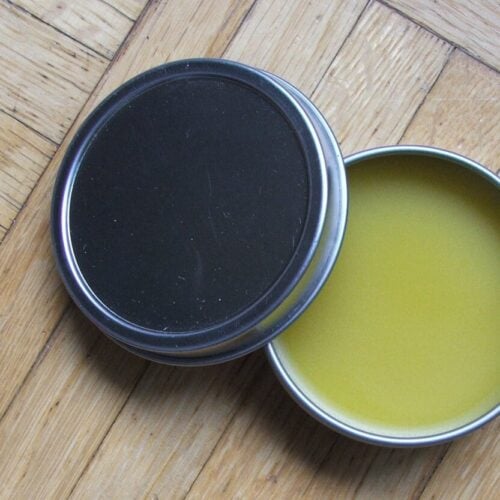Last week, I got a cut that got infected. Like, really infected. I thought I had cleaned it well, and even applied an over-the-counter “Neo-antibiotic,” but overnight, that cut developed a big, angry red ring around it, and became excruciating to the touch and full of pus.
It looked so bad and hurt so much, I feared I might have to go to the doctor for an antibiotic or even minor, outpatient surgery to open it up and clean it out. I used this anti-bacterial ointment recipe instead…
Why Take a Systemic Antibiotic for a Local Infection?
I don’t know about you, but I dread the thought of dealing with the allopathic medical system, and I avoid it whenever possible. I also really don’t want to have to take an antibiotic, particularly since I’ve been on an intensive gut healing diet and supplement protocol for the past month.
An oral antibiotic is a systemic medication, and would have to circulate through my whole body just to get to the infection on my elbow. This would destroy all the hard work I’ve been doing to seal my leaky gut and build the kind of healthy gut bacteria that can help resolve my eczema and food sensitivity issues.
So I decided I would try home remedies for 24 hours and then re-evaluate whether I needed to see the doctor. The infection was so red, painful and oozy, I was skeptical that anything I tried at home would help that much, but I figured I had nothing to lose by trying for just a day—especially if it could potentially get me out of having to take those gut flora-killing antibiotics!
I mixed up a salve containing essential oils with known antibiotic and anti-inflammatory properties, and rubbed it into the wound every 3 hours until bed time.
By the time I woke up, the red ring had greatly diminished, the pain was almost gone, and the wound was visibly improving. I was frankly amazed, and decided the doctor wouldn’t be necessary. Whew!
After applying the salve every few hours for the next 72 hours, the cut no longer shows any signs of infection and is healing very well. Some of the skin around the wound dried and flaked off a bit, but this was harmless.
Better Than That “Neo-Biotic” Stuff
Give this DIY antibacterial ointment recipe a try next time you or your child gets a cut or scrape. It certainly seems to work far better than that store-bought “Neo-antibiotic.”
Just don’t use this on deep puncture wounds or open, bleeding wounds. And if your wound has an infection that doesn’t improve in a short time using this recipe, don’t hesitate to get proper medical attention!
This ointment features a mighty line-up of ingredients:
- Coconut oil is a great anti-microbial base upon which to build your ointment. Unlike your typical DIY salve, I didn’t add any beeswax pastilles to this recipe because I wanted it to easily and quickly penetrate the skin, like an ointment rather than a balm. This means that without the beeswax, you might need to refrigerate this recipe during hot months, though the batch is small enough you will probably use it up quickly.
- Both oregano oil and tea tree oil are powerful anti-microbial oils, and act as strong anti-infection forces in this recipe. (As an added bonus, if you use oregano oil, your cut will smell like Italian food.) Both oils are drying, so you might get a little skin flaking around your cut.
- Helichrysum oil is anti-inflammatory, anti-septic, and great at helping to close up a wound.
- Lavender oil is anti-inflammatory, anti-microbial and calming.
- Frankincense is known for its skin healing properties, and helps with inflammation, too.
Whenever applying essential oils to your skin always perform a small patch test to an insensitive part of the body (after diluting the oil in an appropriate carrier oil.)
Related DIY Recipes
- Dandelion Magnesium Lotion for Muscle Cramps
- DIY Vapor Rub for Colds (and Sore Muscles)
- DIY Thieves®* Oil Blend: A Safe, Natural Disinfectant & Health Aid

DIY Antibacterial Ointment
Equipment
Ingredients
- 2 Tbsp. refined coconut oil, where to find online
- 2 drops oregano essential oil, or tea tree essential oil
- 2 drops helichrysum essential oil
- 2 drops lavender essential oil
- 2 drops frankincense essential oil
- 1-2 tsp. beeswax pastilles, OPTIONAL, if you want a firmer balm (where to find online)
Instructions
- In a small double boiler, melt the coconut oil (and beeswax, if using) just until liquified, then add the essential oils, one at a time.
- Mix the oils together thoroughly, then pour into a small jar or tin.
- Put the mixture in the fridge to solidify.
- Apply to minor cuts and scrapes, and then apply a bandage, if needed.
- Store in a cool location because the salve can melt in hot temperatures.











